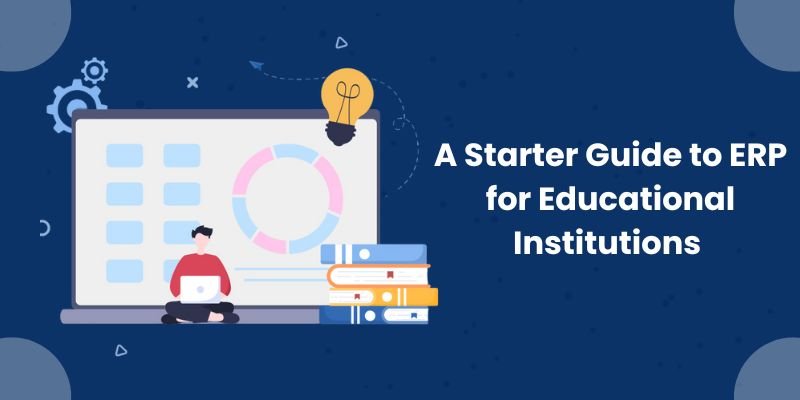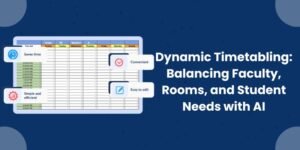Given today’s fast-changing educational world, schools and universities are turning to Enterprise Resource Planning (ERP) systems to boost their efficiency and improve the learning experience. An ERP system brings together various administrative and academic functions into one cohesive platform, making operations smoother and enabling data-driven decisions. This guide dives deep into ERP systems specifically designed for educational institutions, highlighting their advantages, essential modules, implementation steps, challenges, and key considerations.
Benefits of Implementing ERP Systems in Educational Institutions
Streamlining Administrative Processes
By adopting an ERP system, schools can automate everyday administrative tasks like admissions, fee collection, and scheduling. This automation cuts down on manual errors, saves valuable time, and lets staff concentrate on more strategic projects. For instance, the system can efficiently handle student enrollments and create timetables, ensuring that resources are used effectively.
Enhancing Communication Between Stakeholders
ERP systems make it easy for students, parents, teachers, and administrative staff to communicate. With features like portals and messaging systems, important information—such as academic progress and school announcements—is easily accessible, promoting a collaborative atmosphere.
Improving Data Accuracy and Security
By centralizing data in an ERP system, accuracy is improved as it reduces redundancies and inconsistencies. Plus, modern ERP solutions come with strong security features, including encryption and access controls, to safeguard sensitive information and ensure compliance with data protection laws.
Key Modules in Educational ERP Systems
Student Information System
This module keeps detailed records of student information, covering everything from personal details to academic history and disciplinary actions. It serves as a centralized hub, making it easy to access and manage all this important data.
Attendance and Timetable Management
This feature automates the tracking of attendance and the scheduling of timetables, which lightens the manual workload and ensures that records are kept accurately. Teachers can easily mark attendance, while administrators can generate reports to keep an eye on trends.
Examination and Gradebook
This system simplifies the entire exam process, from scheduling and conducting tests to grading and report generation. Teachers can input scores, while automated calculations ensure accuracy in final results, making performance tracking more efficient.
Finance and Fee Management
This feature handles all financial operations, including fee collection, budgeting, and expense tracking. It provides real-time insights into the institution’s financial health and generates detailed audit reports, ensuring transparency and accountability.
Human Resources and Payroll
Responsible for managing staff-related processes, this tool covers recruitment, payroll processing, attendance tracking, and performance evaluations, helping streamline workforce management.
Library Management
Designed to optimize library operations, this system simplifies book cataloging, issuance, and returns while efficiently tracking overdue items, enhancing accessibility to academic resources.
Transportation Management
This function oversees transport logistics, ensuring well-organized bus schedules, vehicle maintenance, and student pick-up/drop-off coordination for a safer and more efficient transportation system.
Hostel Management
This solution facilitates hostel administration by managing room assignments, monitoring occupancy, and handling maintenance requests, improving the residential experience for students.
Inventory and Asset Management
This capability ensures efficient procurement, usage, and maintenance of institutional assets. By tracking inventory in real-time, it helps optimize resource allocation and budgeting.
Admissions Management
Simplifies the whole admissions journey, starting from when applications are submitted all the way to enrollment, making things more efficient and enhancing the experience for applicants.
Alumni Management
Keeps track of alumni records, making it easier to communicate and engage with them for fundraising and networking opportunities.
Steps to Implement ERP in Educational Institutions
Assessing Institutional Needs
Start by taking a close look at what your institution really needs and pinpointing the processes that could use some improvement. It’s important to involve stakeholders from different departments to get a well-rounded view.
Choosing the Right ERP Solution
Dive into research and compare various ERP vendors. Pay attention to their features, customization options, scalability, and support services. Don’t forget to arrange product demos and trials to see how user-friendly they are and if they fit your needs.
Planning and Preparation
Create a detailed implementation plan that outlines timelines, resource allocation, and key milestones. Assemble an implementation team made up of members from relevant departments to guide the process.
Data Migration and System Setup
Start with a thorough audit of your existing data—clean it up, organize it, and map it to the structure of the new system. Run test migrations to catch any potential issues before you go for the full data transfer.
Training and Support
Make sure to provide thorough training for staff and faculty so they feel confident using the new system. Ongoing support is crucial to help tackle any challenges and promote user adoption.
Monitoring and Evaluation
Once the system is up and running, keep an eye on its performance and gather feedback from users. Assess whether the ERP system is meeting the institution’s goals and be ready to make adjustments to enhance its effectiveness.
Challenges and Considerations
Budget Constraints
Implementing an ERP system can be quite the financial undertaking. It involves not just buying the software but also upgrading hardware, training staff, and keeping up with ongoing maintenance costs. Since many educational institutions work with limited budgets, it’s crucial to carry out a detailed cost-benefit analysis. Looking into scalable options and finding vendors that provide flexible pricing can really help make the implementation fit within financial limits.
Resistance to Change
Switching to a new ERP system can often face pushback from staff and faculty who are used to the current processes. This resistance usually comes from a fear of the unknown or worries about added workload. To ease these concerns, it’s important to involve stakeholders early in the selection process, clearly outline the benefits, and offer thorough training. This approach can help build acceptance and make the transition smoother.
Ensuring Data Privacy and Compliance
Educational institutions deal with sensitive information, like student records and financial data. It’s crucial that the ERP system adheres to data protection regulations and has strong security measures in place. Partnering with vendors who prioritize data security and offer compliance features can help protect against breaches and maintain trust within the community.

FAQs
What does ERP mean in education?
ERP stands for Enterprise Resource Planning. In the world of education, it refers to integrated software systems designed to manage and automate a variety of administrative and academic tasks within an institution.
Why do schools need ERP systems?
Schools can really benefit from ERP systems because they help streamline operations, improve communication among everyone involved, enhance data accuracy, and offer real-time insights for smarter decision-making. By automating processes like admissions, attendance, and grading, schools can run more efficiently and focus on what really matters: providing quality education.
What are the steps to implement an ERP system in an educational institution?
Implementing an ERP system involves a few important steps:
1. Assessing Institutional Needs: Figure out what specific requirements and goals you have.
2. Choosing the Right ERP Solution: Look for a system that aligns with your institution’s objectives.
3. Planning and Preparation: Create a detailed implementation plan that includes timelines and resource allocation.
4. Data Migration and System Setup: Accurately transfer existing data and configure the system.
5. Training and Support: Offer thorough training for users and set up support mechanisms.
6. Monitoring and Evaluation: Keep an eye on system performance and make adjustments as needed.
How to train staff and teachers in using ERP software?
Effective training includes several best practices:
1. Assess Training Needs: Identify the specific skills and knowledge gaps.
2. Choose Training Methods: Use a mix of in-person sessions, online modules, and hands-on workshops.
3. Implement Training Plan: Schedule sessions that fit staff availability and learning speeds.
4. Reinforce Outcomes: Provide ongoing support and refresher courses to ensure everyone retains what they’ve learned and becomes proficient.
What challenges might schools run into when adopting ERP systems?
Well, there are a few key challenges they might face, such as:
Budget Constraints: Limited funds can really put a damper on a thorough implementation.
Resistance to Change: Staff might be hesitant to embrace new systems because they’re so used to the old ways of doing things.
Data Migration Issues: Moving data from outdated systems can be tricky and often leads to mistakes.
Integration with Existing Systems: Making sure everything works well with the current software and hardware can be quite a task.
Ensuring Data Privacy and Compliance: It’s super important to stick to data protection laws.
Tackling these challenges calls for thoughtful planning, getting everyone on board, and working closely with seasoned ERP vendors.












